|
FAQs about the Sailfin Tangs, Genus Zebrasoma
Identification
Related Articles: Genus
Zebrasoma, Sailfin Tangs,
Related FAQs: Zebrasomas 1, Zebrasomas 2, Zebrasoma Behavior, Zebrasoma Compatibility, Zebrasoma Selection, Zebrasoma Systems, Zebrasoma Feeding, Zebrasoma Disease, Zebrasoma Reproduction, Yellow Tangs, Purple Tangs, Striped Zebrasoma Tangs, Surgeons In General, Tang
ID, Selection,
Tang
Behavior, Compatibility, Systems, Feeding, Disease,
What the? Who dat?
|
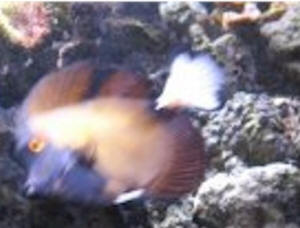
|
Surgeonfishes: Tangs for Marine Aquariums
Diversity, Selection & Care
New eBook on Amazon: Available here
New Print Book on Create Space: Available
here
by Robert (Bob) Fenner |
 |
Juv black tang hybrids
4/30/20
Hey guys
<Hey Tom>
sorry to bother you this late at night but seeing if you guys have
any information on how juvenile black tangs look vs hybrids
We’re talking 2” in size
<It’s hard to tell the difference at this stage since they look
pretty much alike when very young. At an older age, the Z. rostratum
will develop its characteristic long snout; color is another way to
differentiate them, black tangs have a bluish black hue while
hybrids may even show some subtle vertical stripes on its body. Hope
this helps. Wil.>
|
Tang id 3/22/20
Hey guys how are we doing today just got a very interesting one in from our
diver in Hawaii this was imported in with the black tangs and Scopas hybrids
<... this fish came from, was caught in Hawai'i? Lo dudo>
Did not know if you had any extra input on what type of hybrid this is but
it does not match to the other scopas hybrid have this one as you can see
has banding going from the top to bottom of the body and has a very nice
vivid electric blue ring around the outside of the body could this just be
that it’s a half inch smaller?
<Yeah, have seen quite a bit re this apparent hybrid on the Net the last
week or so. The principal story is that the purple tangs they're culturing
at Bali Aquarich are housed, mixed with yellows and scopas; and a few
striped ones with purple and yellow are resultant from crosses between
Zebrasoma xanthurum and Z. flavescens. Time/growth, poss. genetic testing
may tell. BobF>
|
.jpeg) |
|
Positive fish ID 12/5/18
Good evening Sir, This is Dirk from Pattaya Thailand
<Hey Dirk! Reminding me of the Dirt Hash there now!>
Hi guys just spend lots of money buying a Black Tang online from a supplier not
so local to me but local enough to get my stuff back if he swindled me....
Can anyone confirm that a black tang in juvenile stages can have that much white
in his from body or did he deliver me some sort of hybrid scopa? He claims he
contacted his supplier and they claim it will turn black in time?
<I do think this is a juvenile Z. rostratum; mainly from the bend in the snout.
You can see my pix here on WWM:
http://www.wetwebmedia.com/zebrasom.htm
The white will go, and the rostratum will grow longer w/ time/size>
Please advise...Urgent as I would like to confront the supplier here with some
positive (or negative IDs) from experts in the field...
<Don't think this is a Scopas. Bob Fenner>
|
 |
Re: positive fish ID 12/6/18
Mister Brenner,
<Close enough>
thank you for your swift reply and coming from you sounds as good news...some
more pictures just in case you see something you dont like....
<Yes; mainly the downward tilt of the snout is what leads me to believe this is
a juv. Black Tang. BobF>
|
 |
|
Re: positive fish ID 12/6/18
Mister Fenner,
just have a more detailed picture maybe....are the markings a tell?
<Same resp. B>
|
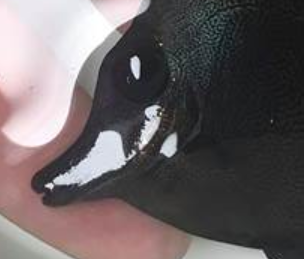 |
|
Help with ID/Zebrasoma ID 7/17/12
Hi
<Hello Shawn>
was on your website reading and I felt that you guys really no <know>
your stuff, So I had a question maybe you can help me with. I need help
to ID.
This beautiful tang I picked labeled as a BLACK TANG rare hybrid. $5.00
yes $5.00 got it found out 2 weeks later it should have been $500.00 &
not $5.00 . Yes wow! So I never asked about the fish I got for $5.00 &
now for that I need your help.
Wrong but wouldn't you snatch it for $5.00 if you could.?
<Yes, ship it out to me and I'll give you 10 and you will have a 5
dollar profit. :-). I believe this tang is a Zebrasoma
rostratum and is restricted to just a few French Polynesian Island
groups, hence its rarity.
Bob may input if my ID is not correct. James (Salty Dog)> <<Is
likely a Z. rostratum. A nice colour. B>>
Shawn C.
More pic of same fish shows color in different light & mood.
Shawn C.
Thank you for the pics and please do not send large photo files in the
future, our server space is not that large, resizing to a few hundred
KBs will suffice. James (Salty Dog)>
|
.PNG)
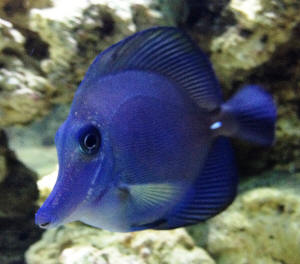 |
|
Help with ID/Zebrasoma ID 7/17/12
Thank you for your quick response, one more question, the color of the
fish I have never seen it before, is that highbred or is that an
original color that's only found in those locations you mentioned in
your previous email.
<That is the only location they are found but there may be some color
morphs.>
Does this fish go by any other specific name, is it a one-of-a-kind or
can I get more, it's a beautiful fish.
<All depends on what is imported from various locations. Best to
check aquarium fish etailers occasionally or ask to be notified if one
becomes available. Be prepared to pay much, much more than 5
dollars for it.>
I would love a tank full.
<You would need a very large tank to reduce aggression amongst them.
Once again thank you for the information. I looked it up it says
it's a black tang yes I got lucky but I've never seen that color so
anymore information all is welcome. To thank you again for your
timely response, I'll correct the picture sizing as well thank you if
you have any pictures of any similar fish I would love to see them on
your site side-by-side so I can see a comparison.
<Google Zebrasoma on our site as well as others. In the future
please check your grammar/punctuation. I really do not have the
time to do this as we are volunteers and only work one to two hours per
day at most. James (Salty Dog)
Shawn C
Help with ID/Zebrasoma ID 7/17/12
Thank you so much!
<You're welcome.>
And you please spell check as well
<<I do.>>
<All depends on what is imported from various locations. Best to
check aquarium fish etailers occasionally or ask to be notified if one
becomes available. Be prepared to pay much, much more than 5
dollars for it.>
Etailers???
<http://www.etailers.com/>
Your completely helpful but be nice!
<I am being nice. I respond to you in a timely manner and all I
ask is that you check your grammar/punctuation so I do not have to do it
before posting. We do not get paid for this work, strictly
volunteer. It wasn't a scolding, simply a
request. James (Salty Dog)>
Shawn C.
Re Help with ID/Zebrasoma ID 7/17/12
Man to man my bad & thank you James (Salty Dog ) for all your
help!
<You're welcome Shawn. James (Salty Dog)>
Shawn C
|
|
Black Tang ID... Scopas to me 11/16/08 Hi
<Hi Michael, Mich here.> These two black tangs have come in
over the last couple of months. I am skeptical as to them being
true black tangs. <I am too.> One (the more bluish one)
looks to be a black/scopas hybrid and the second could just be a
darker scopas. Do you have an opinion of this? <Yes, in my
opinion they are not Zebrasoma rostratum nor do I think them to
hybrids. Take a look at photos on www.fishbase.org and you will
see Zebrasoma scopas that appear this dark and darker. The
Zebrasoma rostratum (from the Latin rostr- meaning beak) has a
longer rostrum or snout than the Scopas Tang. I do not see the
pronounced snout characteristic of the Zebrasoma rostratum in
your photos. I believe them to be pretty Scopas Tangs.>
Kind Regards
Michael
<Cheers,
Mich>
|
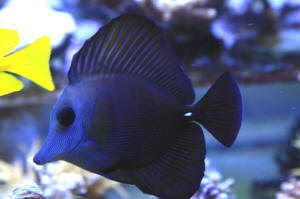 Me too. RMF Me too. RMF |
Yellow Scopas Tang? Doubtful 6/16/07 Specs
90G FOWLR Established for 2 Yrs All readings normal range, nitrates
50ppm, <Dangerously high... should be addressed stat... not allowed
to creep up higher than 20 ppm.> 1Lutascens Wrasse, 1Porc Puffer,
1Majestic Angel, <There is not enough room for these last two
here> 1Yellow Scopas Tang I have a yellow scopas tang, <Ah, not
likely... but could be a cross twixt Z. flavescens and Z. scopas...
these can/do hybridize> as sold to me by the LFS. I was told it is a
rare color morph, that happens naturally. Well my question is first
whether this is actually a yellow scopas tang or a washed out yellow
tang? <... no pic? What, am I, are we supposed to do... guess?>
Is there any physical characteristic that is different between the
yellow and scopas tang? <Some... and there are indeed Acanthurids
that do have all yellow juvenile phases... and even color morphs of
sorts amongst Zebrasoma spp.. But I've never seen a Scopas as
such...> Are they different fish or just different colors? I mean I
have never heard of a brown yellow tang...Your thoughts would be
appreciated, mainly because it is hard to determine its health (because
I don't really know what a healthy yellow would look like for this
fish). It has never been the yellow of a typical yellow tang. It, quite
simply, looks faded. He is healthy and active but it is hard for me to
determine whether his faded color may actually indicate some kind of
deficiency in diet or environment. <Please see Fishbase.org and WWM
for pix... You may have an aberrant colored individual... or a cross...
but w/o images... fin ray et al. meristic counts... There is no way to
tell from here. Bob Fenner>
| Black Tang. Cross between Zebrasoma rostratum,
scopas? 03/26/07 Hello everyone at WWM, <Allan> My name
is Allan. I am from Perth Australia. I have ordered and received a
Zebrasoma rostratum. With one problem... <Mmmm> It convinced
me and my LFS staff ( one of which is quite up to date with marine
fish ) that they have sent a Scopas Tang. Looks very similar but
much more charcoal looking at front end. We are being precautious
and rightfully so. He let me take the fish home and if there is
problems will sort it out. ( I know him personally ) I know there
can be variations in scopas tangs <Yes... principally color,
markings... but some "length of snout"> and they can
be quite black, but the issue is that it is a juvenile 2 1/2".
I and they have rarely seen these fish in the flesh, let alone a
juvenile, and we have no idea what juvenile Black Tangs do look
like. <About like this... do become darker, longer of
"beak" with growth...> I am in good contact with most
of the good LFS in Perth. <Oh, and will be down your way in a
couple of years with a few thousand drunk friends of the Hash House
Harriers...> First of all we compared it to a similar scopas and
the scopas was way browner. We then went to Fishbase and downloaded
the specs on fin count, but couldn't get close enough to count
them ( there is only a slight difference in finnage ). <Best to
make high def., large file electronic images here...> We then
found the greenish line and long snout ( I knew this anyway ),
problem is they develop with age. Believe it or not I have searched
everywhere ( hours ) on the net and cant find a pic of a juvenile
black tang. I have sent 3 photos to you and crew and ask you and as
many people you can who have ever seen a juvenile Rostratum, to try
to give me a guide to what you think it is. Knowledge on such
specialized fish in Perth is limited and I greatly appreciate any
sort of input you have. <I too cannot discern what species this
is... but I do have a suspicion that it/this may well be a cross...
Really, only time, development will tell here likely. Cheers, Bob
Fenner (aka Dogfish in the HHH)> |
| Black tang (Zebrasoma rostratum) ID perhaps
03/26/07 Hello everyone at WWM, <Hi Allan, Mich here.> My
name is Allan. I am from Perth Australia. I have ordered and
received a Zebrasoma rostratum. With one problem... <Not sure
that's what you got?> It convinced me and my LFS staff (one
of which is quite up to date with marine fish) that they have sent
a Scopas Tang. Looks very similar but much more charcoal looking at
front end. We are being precautious and rightfully so. <All say!
Last on I saw sold for $400 USD!!! YIKES!> He let me take the
fish home and if there is problems will sort it out. (I know him
personally) <Mmm careful here.> I know there can be
variations in Scopas tangs and they can be quite black, but the
issue is that it is a juvenile 2 1/2". They and I have rarely
seen these fish in the flesh, let alone a juvenile, and we have no
idea what juvenile Black Tangs do look like. <I do have some
photos of that $400 Zebrasoma rostratum and it was a juvenile.
Sorry for the delay in getting back to you but wanted to confirm
that I did indeed have these photos.> I am in good contact with
most of the good LFS in Perth. First of all we compared it to a
similar Scopas and the Scopas was way browner. We then went to
Fishbase and downloaded the specs on fin count, but couldn't
get close enough to count them (there is only a slight difference
in finnage). We then found the greenish line and long snout (I knew
this anyway), problem is they develop with age. Believe it or not I
have searched everywhere (hours) on the net and can't find a
pic of a juvenile black tang. <I believe you.> I have sent 3
photos to you and crew and ask you and as many people you can who
have ever seen a juvenile Rostratum, to try to give me a guide to
what you think it is. <I have seen one juvenile and it does
resemble. However, I have no formal training on fish
identification, as such, I am afraid to say with any certainty on
such an expensive fish. I will get photos placed on the website so
all can view and opine.> Knowledge on such specialized fish in
Perth is limited and I greatly appreciate any sort of input you
have. <Hope this helps. -Mich RMF any comment?> |
|
.jpg)
|
Sailfin Tang Question...Identification 6/28/06 Hi <Hello
Danielle> Quick question for you. My LFS has a couple of Sailfin
Tangs that looks like a Desjardinii tang, but instead of the whitish
color between stripes it is almost black. They have them labeled as
Australian Sailfins. Is this accurate? <Yes, this is the veliferum
which is found from southwestern to northwestern Australia, and the
entire length of the Great Barrier Reef.> Have you ever heard of
this? Are they the same species as the Desjardin's, but just a
different color variation? <Yes.> Thanks for any help that you
can offer. <Both of these are Zebrasoma. The Zebrasoma veliferum is
found in the Coral Sea, Fiji, Tahiti, Great Barrier Reef, and the Indo
Pacific. The have five vertical yellow stripes and the tail begins in
bright yellow ending with blue highlights. The Zebrasoma Desjardinii is
found in the Red Sea, Maldives/Sri Lanka. These also have vertical
yellow stripes but have light grey freckles on the nose and yellow
freckles on the abdomen. James (Salty Dog)> Danielle
Indian Ocean v. Red Sea Sailfin III 11/11/03 In Calfo and
Fenner's new book Reef Invertebrates they list Z. veliferum as a
potential bubble algae control creature; did they mean to include all
members thereof (including the Pacific or Hawaiian Sailfin) or is the
Desjardin Sailfin the one commonly believed in aquaristics to be the
right candidate? <as stated in the last e-mail, my friend... they
are the same species (Desjardin/red sea Sailfin is simply a Z.
veliferum) but anecdotally they are believed to be more inclined to
rasp bubble algae: <<it is possible that a race of fishes (same
species...different locale) is evolved or predisposed to eating some
prey items over another. There is a strong belief in aquaristics that
this is the case with the Red Sea Sailfin>> best regards,
Anthony>
Indian Ocean v. Red Sea Sailfin 11/7/03 I think this link
answers the question below: http://www.wetwebmedia.com/zebrasom.htm
<Okey-dokey> Desjardin's tang is both from the Indian Ocean
and the Red Sea. <yes... and more importantly, is no longer a valid
species but rather a synonym (same species) with Z. veliferum (common
Sailfin)> Yet the LFS sells the Red Sea for more than the Indian
Ocean. <correct... extra cost of shipping - the most significant
part of the cost of any fish> I want it to eat bubble algae. Does
one do a better job than the other? <it is possible that a race of
fishes (same species...different locale) is evolved or predisposed to
eating some prey over another. There is a strong belief in aquaristics
that this is the case with the Red Sea Sailfin> I also don't
want it to get too big. Does one stay smaller than the other?
<nope... they are all too big and too aggressive for most aquariums
(under 100 gallons or larger if mixed with other tangs). TO control
bubble algae, treat the problem (nutrients, lack of QT, etc) and not
the symptom (the bubbles) for best results. Anthony>
| Mystery tang??? =( Hello, I was wondering if you could
identify this species of tang for me? apparently its very rare and
its face goes blue when feeding or stressed??? NO ONE can seem to
identify this for me and I was told that perhaps you would be the
one to do it!! =) If you could please let me know what it is I
would greatly appreciate it!!! Thanks in advance!!!! <Mmm, looks
to be a very strange color variation of a Zebrasoma species of some
sort... Does happen. Do you have any larger, clearer images? Bob
Fenner> |
|

|
Re: mystery tang??? =( Hello!!! THANK you very much for
the quick response, unfortunately I don't have any other images
...If you had to take a guess, what would you say? <Do you know
where the fish was collected? Please read here: http://www.wetwebmedia.com/zebrasom.htm> My
friend who owns this tang would only tell me that its face would go
blue when feeding and/or stressed ( apparently that was a big hint?
lol)...I'm guessing that it might perhaps be some sort of
hybrid? <Not a hybrid... as in a cross between species... likely
a genetic mosaic however... a "Koi" variety... maybe of
Z. flavescens.> Anyway if something comes to mind PLEASE let me
know!!! Best wishes,
Max |
| Re: My mistake, another photo!!! =) Hello again! ...I
just found another picture that my friend had taken, much
clearer!!!! Any thoughts? Best wishes, Max <Mmm, this pic does
show a much longer "snout"... maybe this is a Z.
rostratum. Bob Fenner> |
|
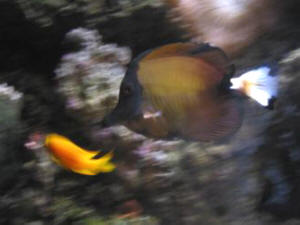
|
Re: My mistake, another photo!!! =) Thank you very
much for all your help, If you have any ideas later on feel free to let
me know!!! I'll keep you updated on the progress of my search!!!
lol <Real good. Thank you. Bob Fenner, still going to get down to
the Mascarenes for that on-sight Gemmatum pic!> Best wishes, Max
Re: is this a real tang? Click here: Gem Tang
Zebrasoma gemmatum I also saw a tang that looks like it's a yellow
tang but it's all orange. Is that a tang also? Jahner <Yes...
these are not common in Hawai'i (where yellow tangs come from) but
are found occasionally... some all orange, but most mottled with orange
and white. Bob Fenner>
Philippine Sailfin Yellow Tang Bob, we have a yellow
Philippine Sailfin Tang that has began getting darker and darker
(brownish tint). We were wondering if you have ever heard of this. He
seems to be in very good health and eats well. Any assistance you might
be able to offer will be appreciated. <<Hmm, well, about the only
Zebrasoma (Sailfin tang genus) members that are shipped out of the P.I.
are Z. scopas (likely the species here) or Z. veliferum... (though
occasional "errant" species are found there...)... And, no
problem with the Scopas changing color as you describe... this is
natural... with this variable species. Bob Fenner>>
Zebrasoma rostratum? I am in the process of setting up a 90
gallon reef tank and have been researching possible fish inhabitants
for this tank. Have noticed Black Tangs on the market, and would like
to know more about them (besides the fact that they are expensive). For
example, is the scientific name for these "Zebrasoma
rostratum" or "Zebrasoma scopas"? How large do
"Black Tangs" typically get in an aquarium? Do they display
characteristics similar to the Yellow Tang as far as what they eat and
how they behave toward other species and to their own kind? From what
part of the world do they come? Thank you in advance for any
information you can give me. I have found your column on this website
to be extremely helpful, and apologize if I missed an earlier
discussing of Black Tangs. Patricia <<Almost all of the
"Black Tangs" on the market are Z. scopas. This species has a
few distinct, though variable color themes, some tan to brown, others
quite blackish. Z. rostratum have very pronounced long
"snouts"; they are unmistakable once you've seen one or
its picture. Scopas get about hand size in captivity, let's say
about 5 inches long overall (up to twice that in the wild). And yes,
they are very similar to Yellow Tangs (Z. flavescens) in diet and
behavior. Scopas are found throughout the mid to western Pacific and
Indian Ocean. Please see the articles on the genus of Sailfin Tangs and
Surgeonfish family at wetwebmedia.com for more. Bob Fenner>>
Scopas v. Rostratum Hi Bob, Since the Scopas tang matter came
up with Joyce, let me ask you a question I was wondering about.
I've seen pictures where the Scopas was jet black. Is there any way
to tell a $20 jet black Z. scopas from an equally-black $200 Z.
rostratum -- other than nose length? <Mmm, they can appear quite
similar when both are small and in good condition and the Scopas
happens to be a darkish one. Most rostratums are significantly darker
overall, have nice blue highlights on the top of the head... and the
nose, long, longer with age, growth. You can see pix, descriptions of
both on www.Fishbase.org oh and WWM! Bob Fenner> Thanks, Dale M.
Re: Scopas v. Rostratum I know this isn't something you
can necessarily pick up on at first site, but what about attitude?
Scopas is reported to be one of the most aggressive z. and very
territorial. Is not the rostratum a more easy going type, like the
yellow tangs? <Hmm, I have found all the listed Zebrasoma to be
about the same type and range of temperament. Z. veliferum, and some
believe the same species in Z. desjardinii can be quite quarrelsome
with growth. Bob Fenner> Dale M.
Surgeonfishes: Tangs for Marine Aquariums
Diversity, Selection & Care
New eBook on Amazon: Available here
New Print Book on Create Space: Available
here
by Robert (Bob) Fenner |
 |
|
|

